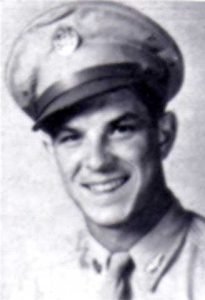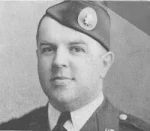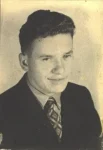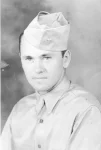Sgt. Frederick Schmidt was born in Maywood, Illinois, on November 30, 1924, to Solomon Schmidt and Amalia Schneider-Schmidt, and had two sisters and two brothers. His family resided at 507 South 11th Avenue in Maywood. Fred graduated from Saint Paul Lutheran School in Melrose Park, Illinois, and Proviso Township High School, Maywood, in 1942. After high school, he was employed by the Charles Bruning Company in Chicago.
He registered with Selective Service on December 29, 1942, and named his mother as his contact person. On March 9, 1943, he was drafted into the US Army and it appears he was selected for the Air Corps because of his score on the Army General Classification Test and that his civilian job skills would be best used in the Air Corps, he was assigned to the Air Corps and given the serial number 36 739 281. It is known that he trained at Sheppard Army Airfield, Wichita Falls, Texas; Lincoln Army Airfield, Lincoln, Nebraska, where he qualified as a waist gunner; Peterson Airfield, Colorado Springs, Colorado, where he attended combat crew training school.
At some point Fred was assigned to the 755th Bomb Squadron, 458th Air Group, 8th Air Force, which was at Horsham St. Faith, England. His plane was a B-24 Liberator named “Chicago Shirl” which was piloted by 2nd Lt. Francis H. Morris. The other members of the crew were 2nd Lt. George W. Ahlsen, navigator; Sgt, George F. Gebhart, tail gunner; S/Sgt. Jerry F. Girardi, Radio Operator; 2nd Lt. William G. Schaudt, co-pilot; Sgt. Philip A. Smith, wing gunner; 2nd Lt. Joseph J. Vacha, bombardier; S/Sgt. James C. Weich, top turret gunner.
The crew’s first mission was on August 12, 1944. The mission was to destroy the airfield at Mourmelon, France. It was stated the mission was a success. The plane took part in three more bombing missions between the 12th and 24th of August. On August 25, 1944, the Chicago Shirl took part in its last mission. That morning the planes took off to bomb Dornier Aircraft Factory in Lubeck, Germany. What is known is that the plane was hit by shrapnel in its right wing while over Lubeck. The pilot and co-pilot managed to keep the plane level allowing seven of the crew members to get out. It appears that Fred, 2nd lt. Joseph Vacha, and Sgt. George Gebhart were wounded or killed when the plane was hit, since none of these three men got out of the plane before it hit the ground and exploded at approximately 10:45 am. The Germans buried Fred in Row 17 , Grave 12, 2nd Lt. Joseph Vacka in Grave 11, and Sgt. George Gebhardt in Grave 13, in the civilian cemetery, Leck, Germany.
The Burger Meister of Waygaard, Germany, Ingwer Peterson, stated in a translated statement.
“In the time from November 1, 1945, I am the Burger Meister from Waygaard. Over the plane crash of an American bomber in August 1944, I can give the following statement. I don’t know the date of the crash.
Before noon, I was standing in my house, I heard a loud detonation. At once I run out my house and observed following: The plane lay on the ground. I saw five (5) men coming down with parachutes in Farretoft, Two other men came down in Herrenkoog. The single parts of the plane lay around in the distance of 500-600 meters north from Waygaard. The police and the Wehrmacht blocked the place of the crash. Near the tail lay one dead flier. Another body was lying in a distance of 400 meters from the wreckages. I can’t say anymore, but I was told that it had been three men. The parachutes of these deceased did not open. One of the living soldiers was burned in the face. It may be that the plane burned in the air before it exploded on the ground. The Wehrmacht took prisoner of the rest of the crew and carried this men at Leck. They got something to eat in the Fahretoft. Also the deceased were carried at Leck were they were buried.”
After the war, the American Graves Registration Service whose job was to recover the dead went to the cemetery. It was noted that eight Americans – from two different planes – were buried in the cemetery. Fred’s name was on the cross marking his grave and that when his remains were recovered one of his ID tags was found with his remains. His remains were casketed and buried in Plot T, Row 2, Grave 46, at the United States Military Cemetery Neuvile-en-Condroz, Belgium. His father received a letter, dated August 21, 1946, informing him where Fred was buried and the location of his grave. It also stated he would receive further information about Fred’s final burial.
Another letter, dated January 15, 1948, arrived from the Office of the Quartermaster General, Washington DC, informing Solomon Schmidt of his options for Fred’s final burial. He was asked to complete an enclosed form and return it to the OQMG indicating where he wanted his son buried. The completed form was received on February 5, 1948, indicating that his family wanted Fred returned to Illinois for burial.
Fred’s casket was disinterred and sent by train, on March 2, 1949, his casket was sent to the OIC Casketing Point, Antwerp, Belgium, where his remains were placed in a new casket. His casket remained in Antwerp until April 22, 1949, when his casket was placed on the USAT Haiti Victory which sailed the same day and arrived in the New York Port of Entry on May 4, 1949. His casket arrived at the Quartermaster Corps Distribution Center #8, Chicago, on May 16th. His casket, on June 13th, was taken in a military hearse to the Paul W. Senne Funeral Home, Maywood, Illinois. Sgt. Frederick Schmidt was buried, on June 14, 1949, in the Mount Auburn Cemetery, Stickney, Illinois, in the Homewood section of the cemetery. Fred’s brother David who was reported missing in action in Italy on May 2, 1944, and declared dead on July 20, 1945.






